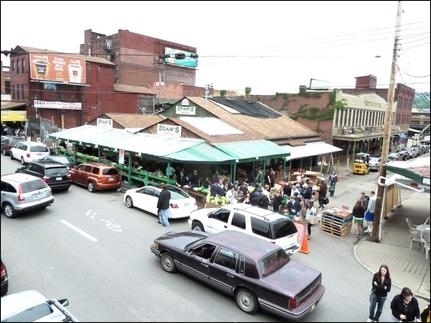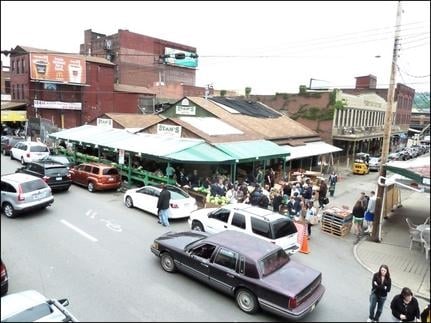
Tuesday night, the City Council reviewed restrictions on commercial street signage and suggested changes including banning portable sidewalk signs on Main Street and other commercial streets.
Last week, while in Pittsburgh, I made my annual pilgrimage to the “Strip District,” a six-block-long section of Penn Avenue — about the length of Santa Monica’s Third Street Promenade. It’s home to specialty markets, bakeries, groceries, antique stores, art galleries, bars and restaurants. Sidewalk souvenir stands with loads of Steeler merchandise compete with fruit, vegetable, flower and temporary food vendors of every conceivable type.
The place is packed, especially on weekends, and at night when the bars and nightclubs in the adjacent warehouses take over.
Signs and merchandise on public sidewalks make them nearly impassable. Many sidewalks have been roofed over and annexed into shops. This visit, vendors had even blocked side streets to sell merchandise.
Back in the day, this was Pittsburgh’s wholesale produce market. There are still wholesalers in the area. Over the last two decades, every possible commercial enterprise has migrated to the “Strip.” And, it appears every rule in the zoning code is being broken — or maybe Pittsburgh’s codes are widely lenient. In any case, nothing seems to be enforced including parking meters.
Not that’ I’d want to see the same chaos here in Santa Monica, but Pittsburgh’s “Strip” attracts a wide variety of humanity from rich to poor, tourist to resident, young and old and every demographic imaginable. It’s a true melting pot, wildly successful and a delight.
Ignored parking tickets hit some nerves
Last week’s column on problems reviewing and processing parking tickets by City Hall and its contractors hit some nerves.
Typical of the e-mails I received was the letter from Hank Rosenfeld in Wednesday’s Daily Press ("Review needed,” May 11, 2011, Page 4). “When I feel I didn’t deserve a ticket and request a hearing, I’ve found I can win maybe one of every four arguments I put forth,” he wrote.
A May 11, 2010 staff report disclosed, “in excess 300,000 parking citations, generating over $16 million …” were issued the previous year.
What are the real odds of beating the system? According to a Dec. 11, 2007 staff report, “Approximately 5 percent of all parking citations are contested and enter the adjudication process.
“Past experience indicates that during the first or initial review phase approximately 62 percent of the violators are found not liable and 38 percent liable,” the report continues. “About 15 percent of the violators found liable at that phase continue to an administrative hearing held by the hearing examiners.”
If you chose to take your case to a hearing examiner, the chances of you prevailing are one in 10. “Of the violators who undergo an administrative hearing conducted by the impartial hearing examiners, past experience indicates about 90 percent are found liable and 10 percent not liable.”
During the last year, “22 violators out of 959 hearings continued to the final or court appeal stage.” If you go to this stage, the odds swing in your favor by nearly three to two. “Of the 22 that went to the final stage, 32 percent were found liable and 68 percent were found not liable,” states the report. I suspect the chances of getting a ticket dismissed have not changed dramatically in the nearly four years since this report was published.
Rosenfeld continues, “Recently, however, I paid the $64 bail and requested a hearing, as did Bauer’s subject in his column. Only this time, I never got a letter scheduling a hearing. Nothing. Zip. Nada.”
I also heard from a number of folks who had the same experience as Harriet did. Individuals, including a friend, told me they received parking tickets, wrote to the Parking Violations Bureau as instructed and asked for dismissals. None of them received any response. My friend decided to pay the $64 and not waste any more time. Other e-mailers wrote they gave up or are “still fighting for justice.”
Bill can be reached at mr.bilbau@gmail.com









